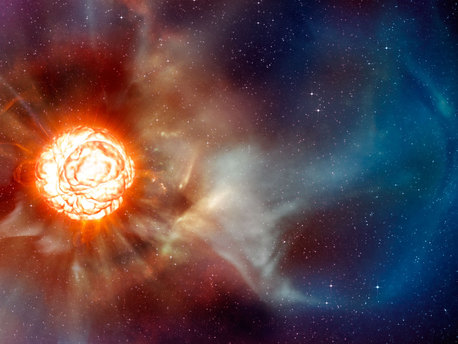Red Giant
Close-up Photos of Dying Star Show Our Sun's Fate
 © ESO/L. Calçada |
Chi Cygni, shown in this artist's conception, is a red giant star nearing the end of its life. As it runs out of fuel, it pulses in and out, beating like a giant heart and ejecting shells of material. Observations by the Infrared Optical Telescope Array found that, at minimum radius, Chi Cygni shows marked inhomogeneities due to roiling "hotspots" on its surface.
As a sunlike star ages, it begins to run out of hydrogen fuel at its core. Like a car running out of gas, its "engine" begins to splutter. On Chi Cygni, we see those splutterings as a brightening and dimming, caused by the star's contraction and expansion. Stars at this life stage are known as Mira variables after the first such example, Mira "the Wonderful," discovered by David Fabricius in 1596. As it pulses, the star is puffing off its outer layers, which in a few hundred thousand years will create a beautifully gleaming planetary nebula.
Chi Cygni pulses once every 408 days. At its smallest diameter of 300 million miles, it becomes mottled with brilliant spots as massive plumes of hot plasma roil its surface. (Those spots are like the granules on our Sun's surface, but much larger.) As it expands, Chi Cygni cools and dims, growing to a diameter of 480 million miles - large enough to engulf and cook our solar system's asteroid belt.
For the first time, astronomers have photographed these dramatic changes in detail. They reported their work in the December 10 issue of The Astrophysical Journal.
"We have essentially created an animation of a pulsating star using real images," stated Lacour. "Our observations show that the pulsation is not only radial, but comes with inhomogeneities, like the giant hotspot that appeared at minimum radius."
Imaging variable stars is extremely difficult, for two main reasons. The first reason is that such stars hide within a compact and dense shell of dust and molecules. To study the stellar surface within the shell, astronomers observe the stars at a specific wavelength of infrared light. Infrared allows astronomers to see through the shell of molecules and dust, like X-rays enable physicians to see bones within the human body.
The second reason is that these stars are very far away, and thus appear very small. Even though they are huge compared to the Sun, the distance makes them appear no larger than a small house on the moon as seen from Earth. Traditional telescopes lack the proper resolution. Consequently, the team turned to a technique called interferometry, which involves combining the light coming from several telescopes to yield resolution equivalent to a telescope as large as the distance between them.
They used the Smithsonian Astrophysical Observatory's Infrared Optical Telescope Array, or IOTA, which was located at Whipple Observatory on Mount Hopkins, Arizona.
"IOTA offered unique capabilities," said co-author Marc Lacasse of the Harvard-Smithsonian Center for Astrophysics (CfA). "It allowed us to see details in the images which are about 15 times smaller than can be resolved in images from the Hubble Space Telescope."
The team also acknowledged the usefulness of the many observations contributed annually by amateur astronomers worldwide, which were provided by the American Association of Variable Star Observers (AAVSO).
source: Harvard Smithsonian Center for Astrophysics
Red Giant
Close-up Photos of Dying Star Show Our Sun's Fate
 © ESO/L. Calçada |
Chi Cygni, shown in this artist's conception, is a red giant star nearing the end of its life. As it runs out of fuel, it pulses in and out, beating like a giant heart and ejecting shells of material. Observations by the Infrared Optical Telescope Array found that, at minimum radius, Chi Cygni shows marked inhomogeneities due to roiling "hotspots" on its surface.
As a sunlike star ages, it begins to run out of hydrogen fuel at its core. Like a car running out of gas, its "engine" begins to splutter. On Chi Cygni, we see those splutterings as a brightening and dimming, caused by the star's contraction and expansion. Stars at this life stage are known as Mira variables after the first such example, Mira "the Wonderful," discovered by David Fabricius in 1596. As it pulses, the star is puffing off its outer layers, which in a few hundred thousand years will create a beautifully gleaming planetary nebula.
Chi Cygni pulses once every 408 days. At its smallest diameter of 300 million miles, it becomes mottled with brilliant spots as massive plumes of hot plasma roil its surface. (Those spots are like the granules on our Sun's surface, but much larger.) As it expands, Chi Cygni cools and dims, growing to a diameter of 480 million miles - large enough to engulf and cook our solar system's asteroid belt.
For the first time, astronomers have photographed these dramatic changes in detail. They reported their work in the December 10 issue of The Astrophysical Journal.
"We have essentially created an animation of a pulsating star using real images," stated Lacour. "Our observations show that the pulsation is not only radial, but comes with inhomogeneities, like the giant hotspot that appeared at minimum radius."
Imaging variable stars is extremely difficult, for two main reasons. The first reason is that such stars hide within a compact and dense shell of dust and molecules. To study the stellar surface within the shell, astronomers observe the stars at a specific wavelength of infrared light. Infrared allows astronomers to see through the shell of molecules and dust, like X-rays enable physicians to see bones within the human body.
The second reason is that these stars are very far away, and thus appear very small. Even though they are huge compared to the Sun, the distance makes them appear no larger than a small house on the moon as seen from Earth. Traditional telescopes lack the proper resolution. Consequently, the team turned to a technique called interferometry, which involves combining the light coming from several telescopes to yield resolution equivalent to a telescope as large as the distance between them.
They used the Smithsonian Astrophysical Observatory's Infrared Optical Telescope Array, or IOTA, which was located at Whipple Observatory on Mount Hopkins, Arizona.
"IOTA offered unique capabilities," said co-author Marc Lacasse of the Harvard-Smithsonian Center for Astrophysics (CfA). "It allowed us to see details in the images which are about 15 times smaller than can be resolved in images from the Hubble Space Telescope."
The team also acknowledged the usefulness of the many observations contributed annually by amateur astronomers worldwide, which were provided by the American Association of Variable Star Observers (AAVSO).
source: Harvard Smithsonian Center for Astrophysics





